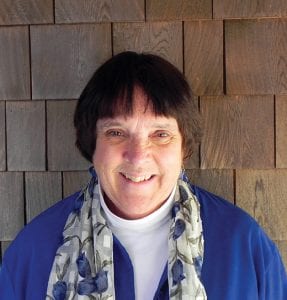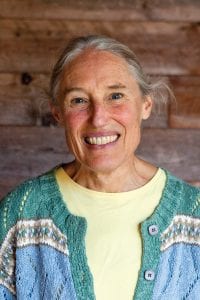In 2019 two people celebrated 30 years with the organization, Conservation Director Sally Stockwell and Scarborough Marsh Audubon Center Director Linda Woodard. We asked them to reflect on those 30 years and some of the accomplishments during that time.

How did you get involved with Maine Audubon?
I started volunteering with Maine Audubon around 35 years ago. My friend saw an article in the paper about volunteering and we signed up to work with Carroll Tiernan in the store at Scarborough Marsh. It was so natural to volunteer there. My mother was a second grade teacher and every year she went to the marsh with her students. I used to go with her and help chaperone the trips when I was in high school.
What are all the different job titles/positions you have held at Maine Audubon?
Volunteer; Store Manager at Scarborough Marsh; Manager, School Science and Natural History Project; Teacher Programs Coordinator; Director of the Scarborough Marsh Audubon Center; Environmental Educator; Out in the Field Coordinator.
In an alternate timeline, what job/career would you have pursued?
I am passionate about animal welfare both domestic and wildlife. I seriously thought about a career more focused on helping animals, whether it was animals that were abused or making sure that animals do not have barriers to living the life they were meant to live.
Do you have a special memory of your years at Maine Audubon?
My most profound memory is when a mute boy spoke for the first time on one of our Nature Explorations. He was a third-grade boy who had not spoken in two years outside of his family. He was with one of our guides and the guide asked him what a group of birds were and he said “Canada Geese.” The teacher was ecstatic. The guide was so moved he left his job and joined the Peace Corps to teach children.
Accomplishments you are most proud of?
Scarborough Marsh: Grew the center and programs offered to engage 8,000 people and 1,500 schoolchildren every year
Literacy: Worked with partners to create and pass Maine’s Environmental Literacy Plan, one of the first of its kind, to develop an environmentally literate population.
Education: Worked with Maine, New England, and North American environmental education associations to advance environmental education throughout the region

What were you doing before you started working at Maine Audubon?
I led wilderness backpacking and canoeing trips for teens throughout Canada and the West from YMCA Camp Widjiwagan in northern Minnesota; worked as an instructor at several residential environmental education programs, including four years at Yosemite Institute (now NatureBridge) where I taught natural and cultural history for teens while I lived and worked in Yosemite National Park. One summer I worked as a park naturalist at Katmai National Monument in Alaska, which you could only access by boat or plane. For several years I taught natural history and birding classes for youths and adults at the St. Paul Science Museum and Bell Museum of Natural History. I was a teaching assistant in wildlife ecology and management at the University of Maine and in ornithology at the University of Minnesota; and was a faculty member at the Metropolitan State University where I taught “The Science and Politics of Conservation”. I also was a graduate student in wildlife ecology at UMaine Orono and the University of Minnesota, where I conducted research on habitat selection and community ecology of amphibians, reptiles, small mammals and birds in peatlands of Maine.
What’s something that existed at Maine Audubon in 1989 that you miss or wish you still had now?
I miss the days before email and I miss the Loon Festival! I don’t miss sharing one office and one computer with five different people.
What are the most significant ways in which the landscape of Maine has changed in the past 30 years?
Here’s a short list that comes right off the top of my head: More development, more roads, more cars, more invasive species, more land trusts, more lands in conservation, tremendous landowner turnover and different landowner goals in the Unorganized Territories, potato fields now broccoli fields, more community gardens and farmers markets, fewer farms, younger forests across much of northern Maine, more invasive species, more bald eagles and piping plovers, more community-based conservation, more frequent and intense storms, shorter and warmer winters. I could go on and on . . .
Many towns in the more populated parts of Maine have adopted land use planning mechanisms that encourage new development in identified “growth areas” and discourage new development in rural areas, but still we are seeing an increased encroachment on Maine’s open space, farms, and forests. More could be done to adopt Smart Growth principles, revitalize our downtowns and village centers, conserve forests and farms, and support our rural economies. Groups like the Southern Maine Regional Planning Commission have come up with some very creative approaches to doing just that.
Across the North Woods, there have been tremendous efforts to conserve substantial acreage through fee acquisition or conservation easements, to “keep our forests as forests”, but more could be done. In addition, on-the-ground management has changed dramatically over this time, leaving much more of the forest in a younger state, with woods roads crisscrossing the land. Despite hundreds of thousands of acres now under conservation easement, ensuring there will be little if any development on those lands, we still need to do a better job of protecting biodiversity through enhanced habitat stewardship.
In addition, species ranges have shifted substantially, with the arrival and/or northward dispersal of species such as Tufted Titmice, Red-bellied Woodpeckers, possum, and gray fox; the loss of our cold-water marine shrimp fishery; and the arrival of warmer-water marine species such as Atlantic Mackerel and Black Sea Bass.
What do you remember about your very first day at work?
It was June 19, 1989. I had just moved across the country with my husband and not-quite one-year-old daughter for this job-share and had not even unpacked before heading in to the office on that fateful Monday. I started working in a scrubby corner of the Farmhouse and was given lots of information about loons to review as my primary responsibility was to oversee the annual loon count and loon festival. It was exciting but daunting as well. Four months later, the person who hired me to job-share left Maine Audubon!
Superpower?
No super powers, but here are a few of my environmental mentors:
- John Muir
- Aldo Leopold
- Sigurd Olson
- Edward Abbey
- Rachel Carson
- Robin Kimmerer
Accomplishments you are most proud of?
Brook Trout: Enlisted 423 volunteers to survey 464 remote ponds and 208 coastal streams for previously unknown populations of brook trout; added 30 ponds to Heritage Waters List; and adopted new rules to reduce use of live fish as bait that could jeopardize wild populations.
Loons: With community members and lake associations, grew the loon population in the southern half of Maine from a low of about 1800 in 1983 to today’s estimate of 3,219. Also enlisted the help of over 1,000 volunteers to support legislation that allows restrictions on certain boating activities that scare loons or wash eggs off their nests, ban certain types and sizes of lead fishing tackle, provide funding for limiting the spread of invasive aquatic plants, and protect water quality through shoreland zoning, the Lake Smart program and other proactive measures.
Coastal Birds: Worked collaboratively with multiple partners to recover seriously endangered populations of Piping Plovers and Least Terns on Maine beaches, growing the plover population from 17 pair in 1981 to 89 pair and 175 fledglings (young that can fly) in 2019.
Forests: Created, mapped, and promoted five Maine Wildland Conservation Areas across the Northern Forest in the 1990s, many of which have since been conserved in small or large part. Worked with residents and businesses in the Rangeley region on Conservation Works!, an effort to blend conservation with a diverse and sustainable natural resource based economy. Trained 1155 landowners, foresters, and road professionals to manage forests and roads to benefit birds, fish, and other wildlife. See our Forestry for Maine Birds guidebooks for foresters, landowners, and loggers.
Vernal Pools: Developed and created several training manuals and community scientist programs to identify, survey, map, and conserve vernal pools and their inhabitants.
Wetlands: Created a strong state wetlands protection law and an in-lieu-fee wetland mitigation program.
Habitat Connectivity: Identified and mapped likely aquatic and terrestrial habitat connectors on Beginning with Habitat maps for towns. Created interactive Wildlife Road Watch web program and supported volunteers to collect data on where wildlife cross roads to identify ‘hot spots’ and ‘high density crossing areas’ where road mortality could be reduced by using signage, fencing, and terrestrial passage through culverts. Developed the Stream Smart program to reconnect our waterways by surveying, mapping, and replacing poorly functioning culverts and bridges to allow streams to flow naturally and fish and other aquatic and terrestrial wildlife to move safely up and down streams.
Siting: Advocated for siting development and energy projects in ways that avoid or minimize harm to wildlife and habitat (think Beginning with Habitat, Penjajawoc Marsh, Redington Mt, and Moosehead Lake). See our latest publication, Renewable Energy and Wildlife in Maine.
Funding: Led efforts to establish the Chickadee Checkoff, Loon License Plate, and Maine Outdoor Heritage Fund to provide additional funding for wildlife and habitat conservation.
